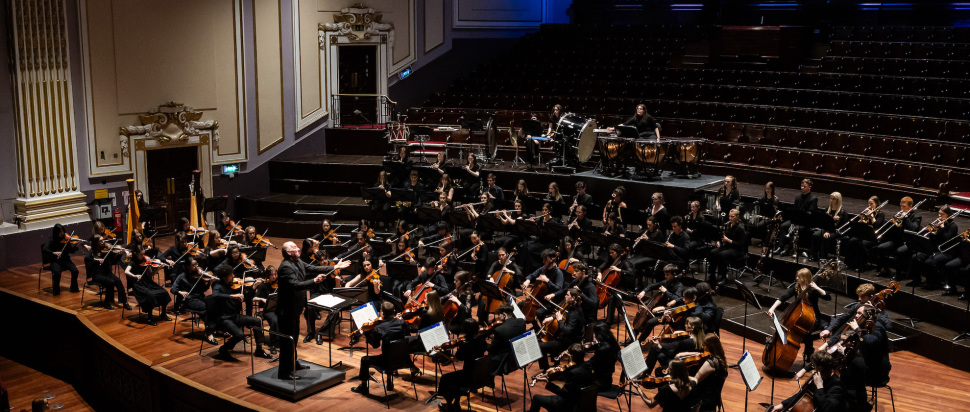Symphonic Youth: National Youth Orchestra of Scotland's Galvanic Dances
The National Youth Orchestra of Scotland are preparing to debut Galvanic Dances, a piece which asks big questions about life and death, and whether or not frogs can do the can-can

A national youth orchestra is kind of like a collective expression of will by a subsection of a nation’s youth – these bodies are the product not just of the talent of their members, but also of focus, of commitment that’s (perhaps unfairly) surprising in such young minds.
The National Youth Orchestra of Scotland (NYOS) has existed for nigh on 50 years and serves as a pathway into the music profession, cultivating and nurturing some of the most dedicated young musicians from across Scotland. It operates on the basis that there’s something important about playing together, about learning from one another – maybe more important even than practising alone in your room for hours on end.
The dedication NYOS’ members bring to the ensemble is rewarded in kind with a serious reception to their work – they are reviewed (often favourably), their efforts weighed up critically and expectations of their capabilities are set high. They have new works commissioned for them by successful and popular composers (who, crucially, are alive to work with the players, provide interpretation and demand their work be represented to a high standard).
Touring internationally for the first time in a decade, next month NYOS will debut Galvanic Dances, a new work by Jay Capperauld inspired by the experiments of Italian physicist Luigi Galvani (from whom we got the inspiration for Dr Frankenstein, and also the word galvanise). In his programme notes, Capperauld explains: “Galvani’s experiments focused on the re-animation of dead frogs’ legs, which moved and twitched when applied with an electrical current. This discovery raised significant questions about the source of life itself and whether death could, in reality, be prevented...
“This concerto for accordion and orchestra is written in one continuous movement that re-ima- gines and re-tells the Frankenstein story in a set of infernal dances through the nightmarish image of a chorus-line of dancing dead frogs’ legs, as though Galvani’s morbid experiments have created a kind of musical Frankenstein’s monster.”
Capperauld’s compositions are often works of intuitive storytelling – he is drawn to the challenge of creative narrative without words. He also has an evident interest in the historical macabre, particularly moments of dark humour. In Galvanic Dances we can expect him to play with the audience, using our notions of accordion music against us. The timbre of the accordion is surrounded by associations with mystery and intrigue across different musical cultures, but for Scottish audiences there is an additional level of baggage as it inevitably conjures the image of Jimmy Shand; of being forced, aged 12, to ask a boy in your P.E. class to dance with you.
These hints at Scottish folk stories and of folk music’s universal intertwining with dance are woven into the fabric of the writing, “with references to various musical dance forms, such as the tango, waltz, jig and tarantella.” Capperauld couldn’t have chosen a more apt collaborator for this cross-genre journey – soloist Ryan Corbett has built his career to date by pushing on the boundaries of traditional repertoire. He is the first accordionist ever to win a place on BBC Radio 3’s New Generation Artists Scheme, and takes a special interest in playing music written before the accordion was invented.
In commissioning one of Scotland’s most in-demand composers to write for their young players, the orchestra is adding to the body of work that is the Scottish national repertoire, and showing young instrumentalists that they have a role to play in that. For Capperauld, it “continues the development of orchestral repertoire in a meaningful way by exciting and encouraging young musicians to explore new music with a living composer.” It’s not a coincidence then, that support for the commission has come from the Vaughan Williams Foundation, whose remit is supporting composers and keeping composition a living, breathing pursuit, and the Richard Chester Creativity Fund, so named in memory of the former Director of NYOS, whose achievement was nothing short of the explosion of professional-standard youth music in this country.
NYOS’ summer concerts mark the orchestra’s first tour outside of the UK in ten years – they begin in Perth on 1 August and continue onward to Liverpool, and Saffron Walden, before performing at the prestigious Young Euro Classic festival in Berlin. The Perth premiere of Galvanic Dances will be the only chance to see them on their native turf. Taking the young players outside of Scotland is significant for many reasons: personal growth, exposure to other approaches to music, other types of audiences. But at NYOS it’s about showing those audiences, and most importantly the players, that Scottish talent is deserving of a worldwide audience.
NYOS Summer Tour: Perth Concert Hall, 1 Aug, 7.30pm; Royal Liverpool Philharmonic Hall, 2 Aug, 7.30pm; Saffron Hall, Saffron Walden, 3 Aug, 3.30pm; Konzerthaus, Young Euro Classic, Berlin, 6 Aug, 7pm
